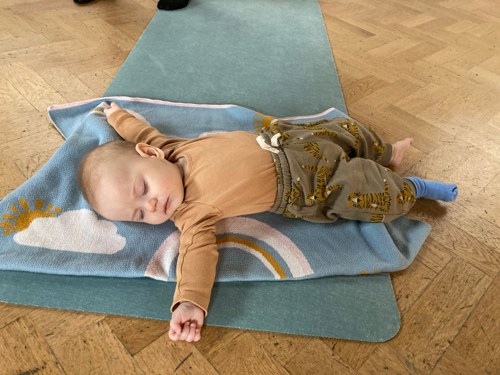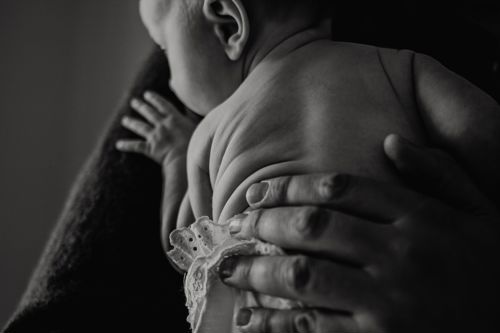Starting baby yoga - some tips!
My classes are a mixture of yoga postures and movements for baby, postnatal yoga and some all-important space, for parent/child bonding. This blog will focus on the benefits of practising yoga with your baby, and some tips around how to go about starting yoga with your baby.
A baby’s development mirrors some of the classical Hatha Yoga postures – for example, downward facing dog appears when baby is starting to crawl, and then again when they are trying to walk. Babies are natural yogis – they are only concerned with the present moment, and they love unconditionally.

The benefits of yoga for baby:
- It’s calming – which is something babies need our help with. They essentially ‘borrow’ your nervous system to help regulate their own. Touch and movement helps them do this, especially in the early weeks.
- They sometimes struggle with their digestion and gas – the poses help your baby to digest effectively and reduce tummy pain
- Bonding – with newborns this could be through shared gaze, or simply holding them in a certain way, with older babies this may be more active and playful. It’s not always about the amount of time you spend with your baby, but the quality of that time.
- To help improve sleep quality and length – lots of people find their baby does a lovely long nap after class! The movements that we do in class can be tiring for baby, you may also find they are more thirsty/hungry too.
- To support their neuromuscular development and increase body awareness. The movements also support their vestibular system and sense of balance.
Tips for newborns and younger babies
Generally, the smaller the baby, the slower the transition time, and the slower the movement, especially if the movements are new to them. When you’re starting with your newborn, 3-5 repetitions can be great, and slowly build up from there. Repetition gives baby a sense of safety, familiarity and predictability – something we enjoy as adults too!
When to practise
Babies are generally happy when they’ve just been fed, and not overly tired. As adults, we typically wait after eating to exercise, but babies digest a lot quicker and the movement can actually aid digestion. Waiting 15 mins after feeding your baby may be enough, just being mindful of any big movements and pressure on the tummy, to avoid any milk spit up (particularly if your baby has reflux, then you may want to wait around 30mins).
How long should a baby yoga sequence last?
It could be as little as a few seconds, and as long as half an hour or more. It will depend on how your baby is feeling, their age and how much time you have in the day. There are some ‘magic poses’ that can be useful wherever you are, in helping to reduce fussiness quite quickly in baby, whilst you’re doing them (at the supermarket or coffee shops for example) and there are times when you’ll be at home in a calm space, and ready for a longer sequence of movements.

Your baby sets the agenda and we respond
Yoga isn’t something you do TO your baby; it is something they do WITH you – this means we have to meet them where they are. Some weeks they may be more unsettled than others for various reasons (post-illness or immunisations, developmental changes, teething, weaning etc).
It’s time to surrender expectations – let your baby set the tone. If you practise just one pose with your baby, that’s great. Some weeks your baby will want to do more, other weeks less.
What we can do is constantly check in with baby – before starting baby yoga we ‘ask permission’ through gaze, voice and touch. If baby signals at any point that they don’t want to continue, they might turn their head, put their hands up in front of their face or go rigid and arch their back. ‘Yes’ cues from your baby might look like held gaze, smiling, talking back to you. We can also talk through transitions, such as saying to your baby, ‘I’m going to pick you up now’, and even giving them a countdown ‘1,2,3, up!’ to give babies time to register what’s happening, and reinforces that predictability.
At any point if baby becomes hungry, needs a change, or becomes tired, it’s ok to stop and support your baby’s needs – even if that means you’ve only just started.
As you practise yoga with your baby over the weeks, you’ll come to notice their preferences for poses and sides. If at any point your baby becomes stiff, you could use a lighter touch and slower pace. If your baby looks off to the side, then keep your hands placed on them, singing their name, until they make eye contact again.
What do I need when practising at home?
Where temperature allows, practise with baby in their nappy (or nappy free if you’re feeling brave!) – it helps them even more with their natural movements. Have pillows nearby for you and baby – some babies like to be propped up with a blanket, especially babies with reflux symptoms. Calming music (similar music each time, so that it becomes a cue for baby) and a small toy to help guide babies head turning in different directions. A mirror (full length if possible) can be fun to practise with, allowing you to see your baby’s reaction when facing them out.
The sing and do technique
The sing and do technique can be practised with any of the postures. It is a playful inflection with a melodic voice, it helps set the tempo of movements so babies start to learn about pace, it helps babies to learn through repetition, and help them engage with the movements. Singing has a massive effect on brain development, and we narrate what we are doing a lot in my classes (for example, singing “toes, to nose”)
What happens if my baby cries or is unsettled?
No one hears your baby crying as loudly as you do – babies are extremely sensitive and are affected by how others feel in the room. Often in class, if one baby starts to cry the rest will start too, because babies aren’t aware of where they stop and the world begins – so in that sense we are literally all in it together!
When your baby is unsettled during yoga, the first thing to remember, is to breathe – then slow down the movement or stop altogether if baby isn’t happy. Perhaps it would be better to return to the movement another time when baby is more settled – sometimes this might mean trying again tomorrow or in a couple of weeks-time.
If your baby has reflux, yoga can be really helpful for them to build tone around the digestive tract. A wedge pillow (or something similar) may be helpful to prop baby up on an incline, rather than being flat on their back, so that their head is higher than their stomach.

Relaxation with your baby
When you’ve practised yoga with your baby, however long that lasted, resting and relaxing with them afterwards can help them understand the rhythms of periods of activity and rest, throughout their day. It can be a time of bonding and getting to understand each other more during a peaceful state (baby willing!). It’s not always possible, as baby may be needing to sleep/feed/change nappy, but where possible and where the opportunity arises to take a moment of calm – take it!
Position ideas:
- Heart to heart, belly to belly (laying down on your back)
- Next to me (laying on your back or on your side)
- Baby sitting between your legs, facing away from you (laying down on your back, legs in a 'V' position)
Tips for resting:
- Be in the moment, listen to your baby’s babbles and coo’s.
- Breathe your baby in if you’re holding them, feeling their warmth and the softness of their skin
- Close your eyes, or gaze softly over your baby, taking in their features
- Set the mood of the room, making it dark, quiet/soft music, scents etc
I hope these tips have been helpful for you! If you're local to Cirencester, I'd love to see you at a class sometime soon, please do get in touch sinead@sineadyoga.com.